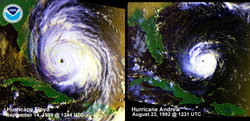
Hurricane Severity Index
Encyclopedia
The Hurricane Severity Index (or HSI) is a hurricane rating system which defines the strength and destructive capability of a storm. The HSI uses equations which incorporate the intensity of the winds and the size of the area covered by the winds. The HSI attempts to demonstrate that two hurricanes of similar intensity may have different destructive capability due to variances in size, and furthermore that a less intense, but very large hurricane, may in fact be more destructive than a smaller, more intense hurricane. HSI was developed by a private company program in competition with the National Weather Service
's Accumulated cyclone energy
index.
by Chris Hebert and Bob Weinzapfel, two ImpactWeather meteorologists and hurricane experts. ImpactWeather officially announced the HSI in 2006. Their goal was to create a new index that rates the severity of all types of tropical cyclone
s (not just hurricanes) based on both their intensity and size of wind field.
 The idea behind the Hurricane Severity Index is that the size of a hurricane is as important as the strength of its winds. Thus, the index uses a 50-point scale, with half of the total based on wind intensity, and half based on the wind fields.
The idea behind the Hurricane Severity Index is that the size of a hurricane is as important as the strength of its winds. Thus, the index uses a 50-point scale, with half of the total based on wind intensity, and half based on the wind fields.
National Weather Service
The National Weather Service , once known as the Weather Bureau, is one of the six scientific agencies that make up the National Oceanic and Atmospheric Administration of the United States government...
's Accumulated cyclone energy
Accumulated cyclone energy
Accumulated cyclone energy is a measure used by the National Oceanic and Atmospheric Administration to express the activity of individual tropical cyclones and entire tropical cyclone seasons, particularly the North Atlantic hurricane season. It uses an approximation of the energy used by a...
index.
History
Development of the Hurricane Severity Index began in 2005 after the 2005 Atlantic hurricane season2005 Atlantic hurricane season
The 2005 Atlantic hurricane season was the most active Atlantic hurricane season in recorded history, repeatedly shattering numerous records. The impact of the season was widespread and ruinous with an estimated 3,913 deaths and record damage of about $159.2 billion...
by Chris Hebert and Bob Weinzapfel, two ImpactWeather meteorologists and hurricane experts. ImpactWeather officially announced the HSI in 2006. Their goal was to create a new index that rates the severity of all types of tropical cyclone
Tropical cyclone
A tropical cyclone is a storm system characterized by a large low-pressure center and numerous thunderstorms that produce strong winds and heavy rain. Tropical cyclones strengthen when water evaporated from the ocean is released as the saturated air rises, resulting in condensation of water vapor...
s (not just hurricanes) based on both their intensity and size of wind field.
Components of the Index

- Size (1-25 points)
- Examines the total coverage of the 39+, 58+, 74+ and 100+ mph wind fields.
- Intensity (1-25 points)
- Points assigned using the relationship between wind speed and the force exerted on an object.
Determining Size Points
Wind radii data from every named storm since 1988 was studied. From these data, average wind radii ranges of four wind fields (39, 58, 74, and 100 mph) were calculated. Once the typical ranges were established, each wind field range was divided into sections. Since hurricane-force winds are much more damaging than tropical storm-force winds, the size scale is weighted more toward the 74 and 100 mph wind fields. With the HSI, a tropical storm can receive no more than 7 total points for size.| Wind Radii | Size Point Range | |||
|---|---|---|---|---|
| 35 kts | 1-3 | |||
| 50 kts | 1-4 | |||
| 65 kts | 1-8 | |||
| 87 kts | 1-10 | |||
| Source: ImpactWeather | ||||
Determining Intensity Points
Wind force on an object is a quadratic function (twice the wind speed equals four times the wind force), thus, the intensity scale is also quadratic in point value, e.g. 1 point for a 30 kt (35 mph) tropical depression and up to 25 points for a hurricane with winds above 150 kts (175 mph).See also
- Beaufort scaleBeaufort scaleThe Beaufort Scale is an empirical measure that relates wind speed to observed conditions at sea or on land. Its full name is the Beaufort Wind Force Scale.-History:...
– For winds less intense than hurricane strength. - Fujita scaleFujita scaleThe Fujita scale , or Fujita-Pearson scale, is a scale for rating tornado intensity, based primarily on the damage tornadoes inflict on human-built structures and vegetation...
– For tornado intensity with damage correlated to wind speeds. The system was also intended for applicability in hurricanes and indeed is utilized by engineers in hurricane damage assessment. - Severe weather terminologySevere weather terminologySevere weather terminology is different around the world, varying between regions and countries. These are articles which explain terminology in various parts of the world.*Severe weather terminology *Severe weather terminology...
- List of tropical cyclones
External links
- Hurricane Severity Index
- Hebert, Chris, Bob Weinzapfel and Mark Chambers. “Hurricane Severity Index: A New Way of Estimating a Tropical Cyclone’s Destructive Potential”. 29th Conference on Hurricanes and Tropical Meteorology, 10-14 May 2010, Tucson, Arizona. American Meteorological Society. http://ams.confex.com/ams/29Hurricanes/techprogram/paper_168529.htm

